Please view these information tabs to help get Mechanical Clock Hands.
Removing Mechanical Clock Hands
Removing Mechanical Clock Hands is fast and easy to do. The following are hand removal instructions for German mechanical movements post WW2.
German Post WW2 wall, mantle and floor models
Removing mechanical clock hands for post WW2, mantle and floor clocks is quite simple. Turn the hand nut to the left while holding the minute hand with your fingers.
Use some small needle nose pliers to loosen the nut first. Once the nut is loose, turn it with your fingers until it comes off.
Then the minute hand will be able to wiggle straight off its square arbor and off of the clock. The hour hand is a friction fit, so just twist the hour hand back and forth and pull toward you until it comes off.
If having a second hand bit, that is only a friction also, so just grab it with your fingernails, twist and pull off.
American Antique time and strike
These type of movements come in two styles. If there is a minute hand nut, the first style is the same as above.
Be very careful not to lose this hand nut. They are very hard to find and replace. The second style of mechanical clock hands will have a pin holding the minute hand on instead of a nut.
This pin tapers, meaning it's fat on one side and skinny on the other. Just grab the fat side with needle nose pliers and yank the pin out. The minute hand will fall out with a washer.
Save the washer and the tapered pin for ease of reinstalling the hands. If these items happen to get lost, Clockworks offers washers and taper pins for purchase, as well as replacement mechanical clock hands.
German Mechanical-Clock Hand Installation
The installation of a German Mechanical-Clock Hand on a German mechanical movement is quite simple. It is simply the opposite of the removal process.
The minute hand must go through some adjustments if you are replacing the movement. Also if the hands are new. This is so it will point to the correct time when it chimes.
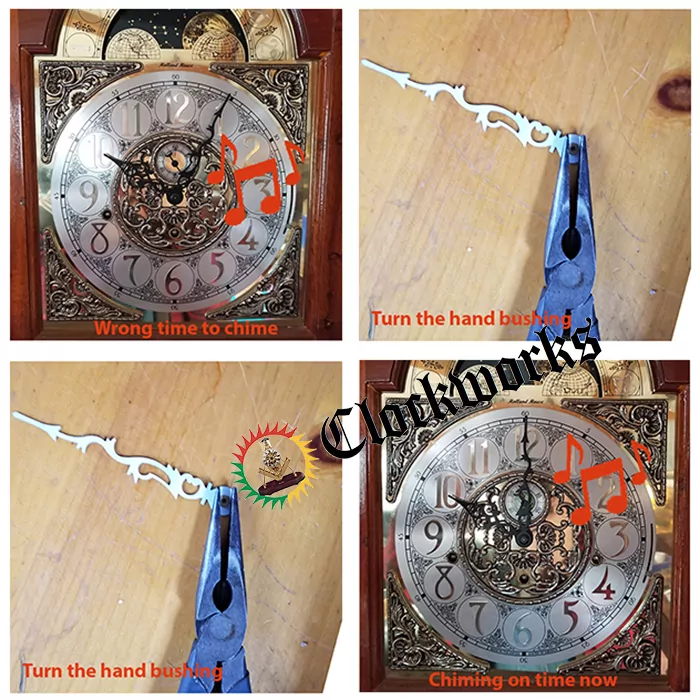
Installing the hour hand
First comes the hour hand. The hour hand is simply a friction fit. All you have to do is put the hand on its round post. Then twist and push toward the front of the dial.
Make sure that it is not in contact with the dial at any point during the rotation.
This includes the base of the hour hand. It cannot rub against the hole that is in the clock face. So, the clock can stop at any point if the hour hand touches anything. You can turn the hand to point to whatever hour it is because it is only a friction fit.
Installing the minute hand
Second, comes the minute hand. Install the minute hand by lining up the the square hole in the hand with the square post of the hand shaft. The bottom of the minute hand cannot be rubbing the hour hand tube or the hour hand. Push the hour hand down further onto the tube if the minute hand is rubbing.
Therefore, it is imperative to check the positioning of the hands to ensure they are not touching anything. Once the minute hand is on its square post, it's time to put the hand nut on.
Tighten the nut with your fingers and then use a pair of needle nose pliers to make it secure. It does not have to be extremely tight. However you need to ensure it is tight enough so that the hands do not come loose as they go around the clock.
Mechanical Clock Hands
German mechanical clock hands are sold by the time track diameter. This measurement is important when ordering these mechanical clock hands. To clarify, the dial diameter is the measurement of the time track.
This means from just outside the 9 straight across to just outside the 3. For example, if the time track diameter is 6 inches, then select hands for a 6 inch time track in the drop down list. Hands for a 6 inch time track will have a minute hand of about 2 7/8 long from the mounting hole to the end.
The hour hand, which is proportionally smaller, will come with the minute hand. This measurement is vastly different than the way you measure quartz clock hands. So be sure to follow these directions for measuring and not the ones for the quartz hands.
Ordering Hands
Choose a style of mechanical hands after getting the time track diameter. There is a drop down menu under each style of hand. Look to see if the style comes in the size you need for the clock.
Not all styles of hands come in the same sizes. So you have to look at the different options available. Serpentine and spade are the most popular mechanical clock hand styles.
Remember, the minute hand will be a little less than half of the time track measurement. The hour hand will be proportional in size to the minute hand.
How they are sent
So, when ordering mechanical clock hands, remember that they come as a pair, hour and minute hand. They ship the next business day from Clockworks in Huntington MA USA, via the method that is chosen upon checkout.
Mechanical Clock Chime On Time
These are the directions to get a German mechanical clock to chime on time. This means having the clock hands point to the right spot when the clock chimes.
When replacing a clock movement, or getting new clock hands, either one, you will notice it will chime 5 minutes before it should, or 10 min after, something like this. This page explains how to correct this situation. It is unbelievably fast and easy to do.
Working with the minute hand
After the installation of a new mechanical movement , or if you are just installing a new set of hands, you may notice the clock will not chime at the time it should.
To correct this, take the minute hand off of the clock. This is the longer of the two hands.
With this minute hand off of the clock, turn it upside down and look that it has a square hole where it attaches to the clock. This square hole is in a bushing that will rotate WITHIN the minute hand itself.
The correction
So, all to be done is just use needle nose pliers to turn this bushing ever so slightly. Put the hand back on the clock and see if it’s pointing to the correct place where it should chime.
If it is, then it all set and it will point to the exact place it should be pointing to. If it is still not right, take the hand off and try again. Once you get the minute hand to point to the correct chime you then set it to the correct time.
The conclusion
It is really that easy, there is nothing to do with the clock itself, only the minute hand. In other words, to put it in a silly way, take the minute hand off of the clock and walk to the garage with it.
Take it far, far away from the clock. When in your garage take needle nose pliers and turn the bushing within the hand itself. Then walk back to the clock and put it on. See if it's now pointing to the right spot.
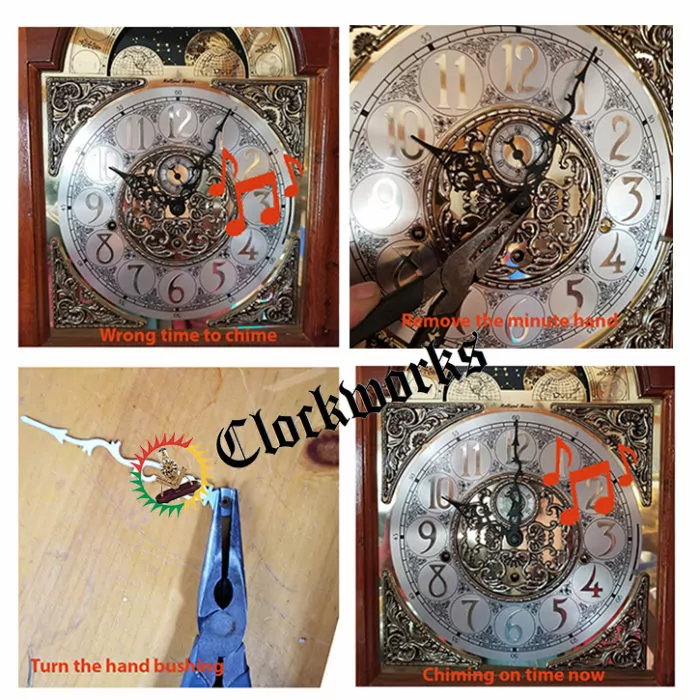
Mechanical clock hand nuts
One of the most common parts a Mechanical clock needs is the hand nut. As we said before, the older the clock the harder things are to find. So, the hand nuts Clockworks offer are for movements made after the 1930's.
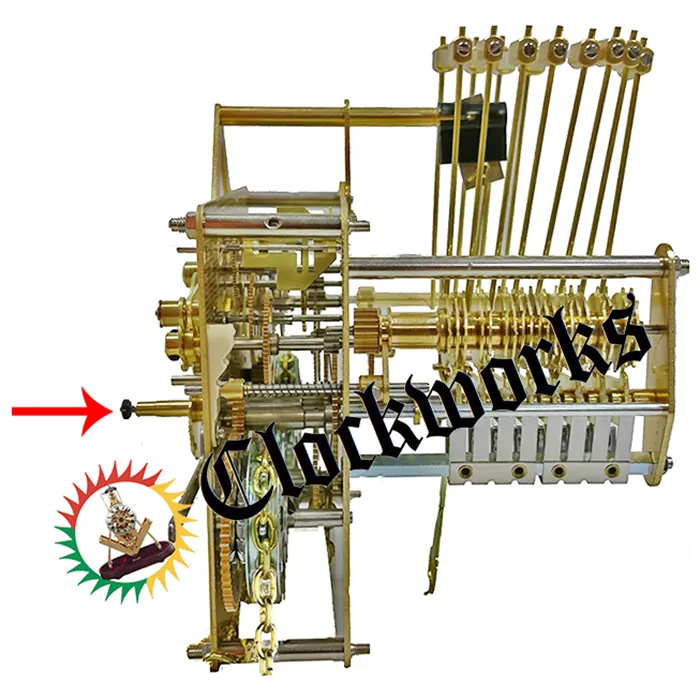
Prior to 1930 clock hand nuts
There were not many standards on what the hand nut size should be on the early clocks. However, prior to around 1930 there is no telling what will work. In other words, it is literally trial and error. There was no standard hand nut size.
Subsequently, any hand nut we offer, may, or may not, work. This includes cuckoo hand nuts, American clock hand nuts, or German hand nuts. However, with even all of these assortments, there is a chance none of them will work on the clock.
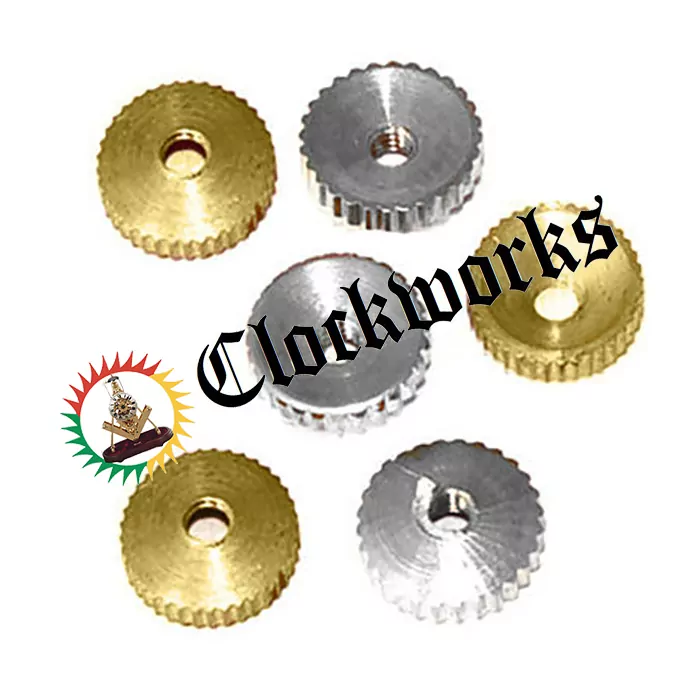
Post 1930 clock hand nuts
Generally speaking, what we have to offer in the three types of clock hand nuts will cover most of the post 1930 Mechanical clocks.
The cuckoo hand nuts fit about 80% of the post war German made cuckoo clocks.
So, the American clock hand nuts fit many of the mechanical time strikes that were so popular. German hand nuts fit most post war German made mechanical clocks, with the exception being a few large grandfather clocks.
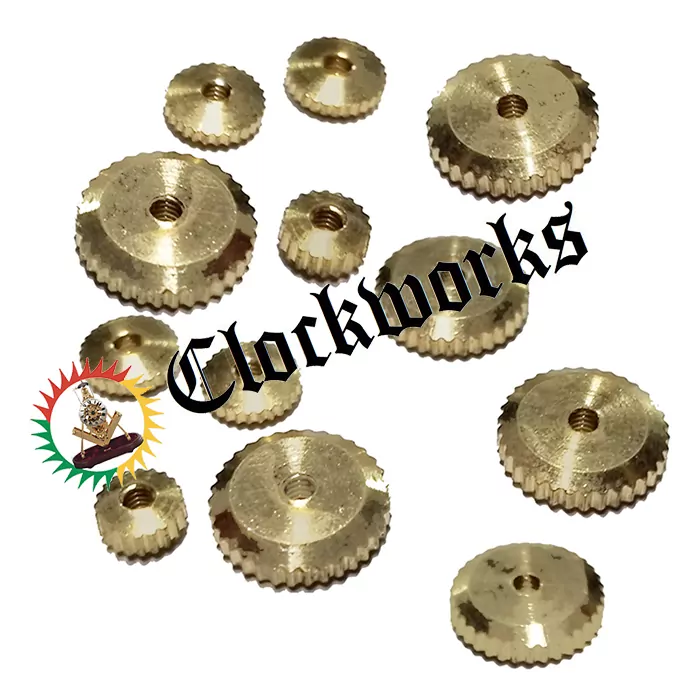
Clocks that do not take a hand nut
However, not all clocks require a hand nut. Some antique mechanical clocks require a clock hand washer and a tapered pin instead. These secure the minute hand as an alternative to the hand nut.
The washer may have a small square hole, or large, oblong or round hole. Clockworks offers an assortment of 100 clock hand washers that includes all the styles above. Use a taper pin to secure the hand with the washer on top of it.
Insert the taper pin into the hole in the end of the minute hand arbor to secure the washer and minute hand to the clock. A taper pin is a small brass or steel rod that is wide on one end and skinny on the other. Clockworks offers them in an assortment of 100 to ensure the right one is there.
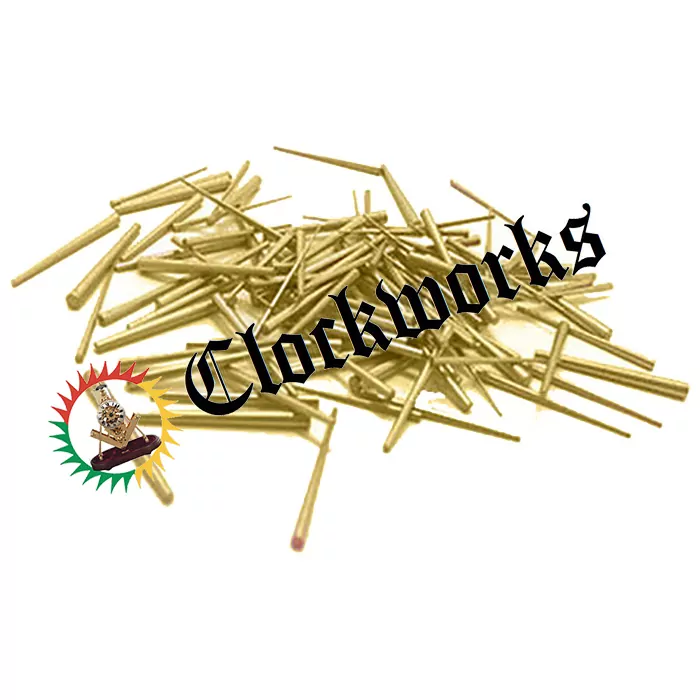
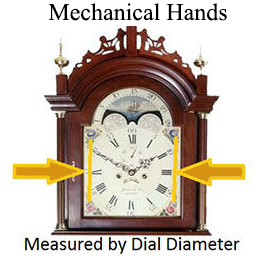
Spade Clock Hands
These hands fit antique 8-day time strike units made in the USA for a 5-inch time track. They accommodate American antique movements such as ST, Sessions, New Haven, Ansonia, Gilbert, and Waterbury.
These hands are available with either a 4mm wide square mounting hole or an oblong mounting hole 2.5mm wide, 5mm long. The hour hand comes with the minute hand and has a round mounting hole with a brass sleeve. It is, of course, shorter than the minute hand, and we sell these hands as a pair.
Fit many but not all
They do not guarantee a perfect fit, but they usually solve the problem. The clock movement industry had more non-standard variations, especially in older clock movements. This means these hands offer the best chance of finding suitable replacements for the clock. It applies most to movements produced in the USA during the first 50 years of the 1900s.

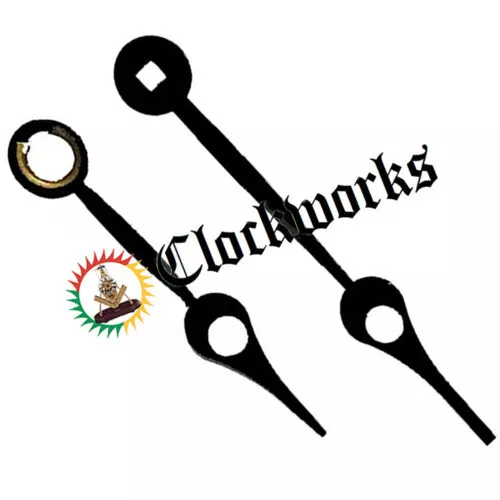
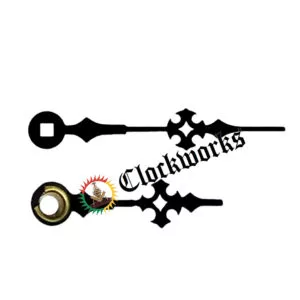
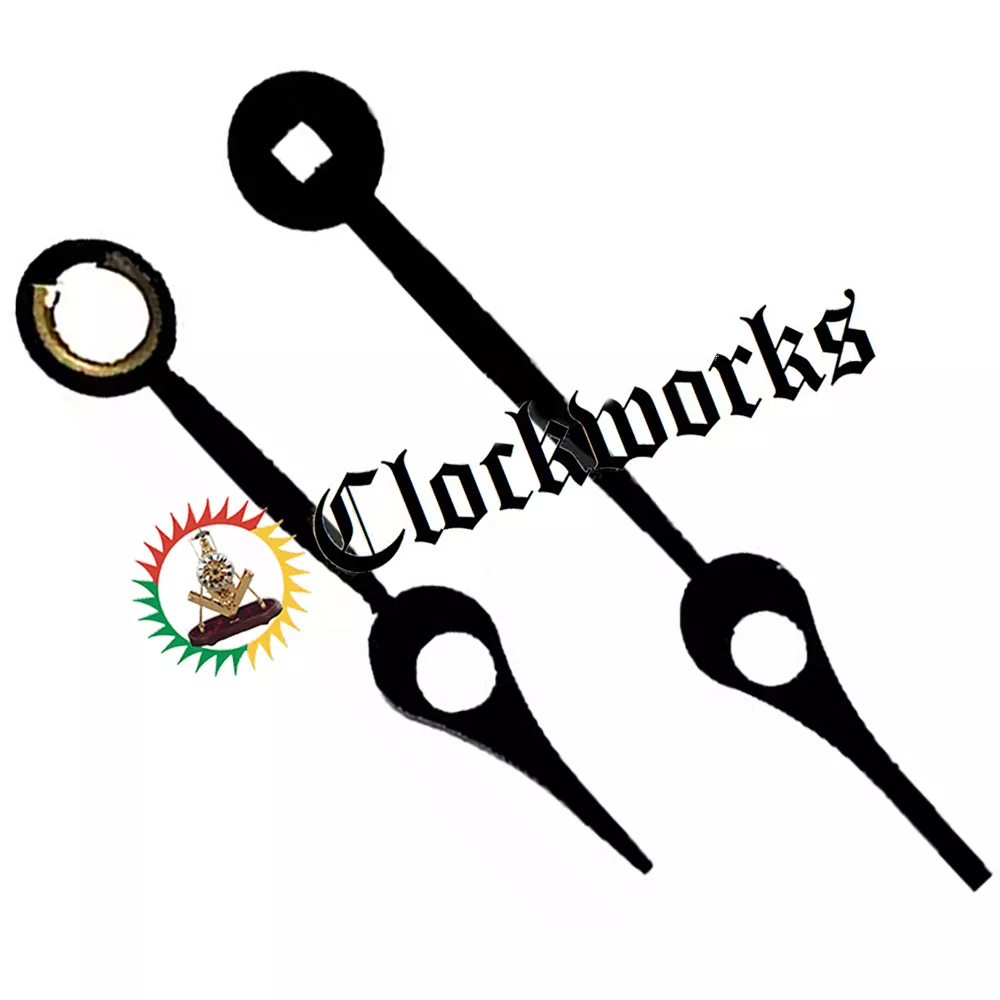
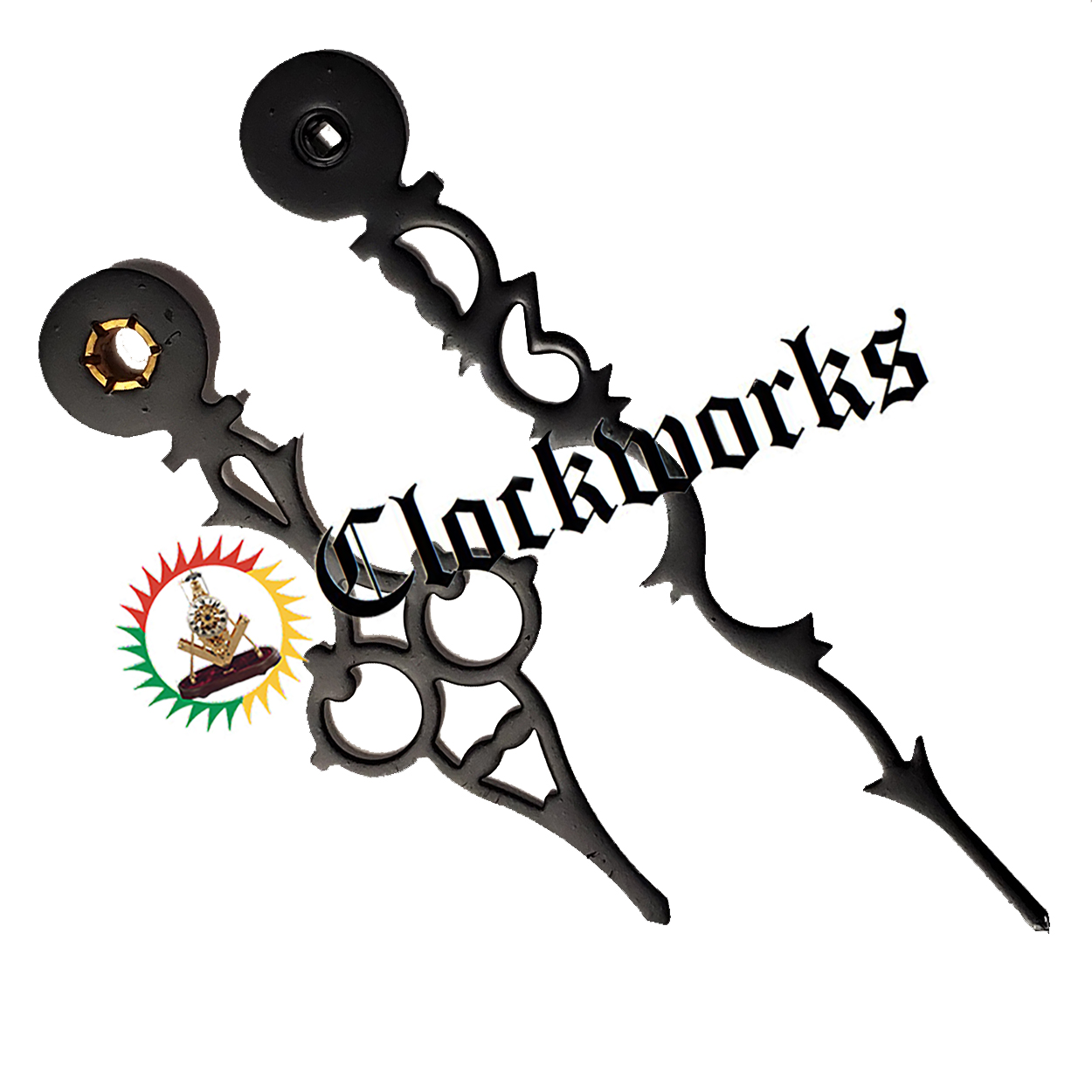
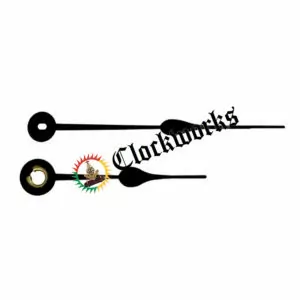











Hands are approximately 3.5 inches and don’t see option for them.
Does not come in this pierced spade clock hands style
James
Do these hands come with the bushing needed to synchronize the minute hand with the chime?
No these do not have the bushing in the minute hand. You maybe looking for German clock hands https://www.clockworks.com/product/serpentine-hands-for-german-mechanical-clocks
James
Thank you !